Pests
Know Your EnemyRodents
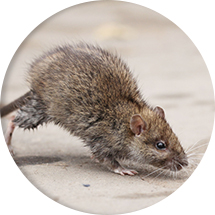
Brown Rat Rattus norvegicus
Appearance:
- Up to 40 cm in length, with a tail shorter than the head and body.
- 350g – 500g in weight.
- Blunt nose, small ears and a thick body.
Life Cycle:
- 6-8 young per litter.
- 3-4 litters per year.
- Gestation period is 3 weeks.
- Sexual maturity is reached 12 weeks.
Habits:
- Burrows underground and found in sewers.
- Eats about 25-35g of food and approximately 60ml of water per day.
Control:
- Trapping – Proofing – Rodenticides – Tamper Proof Bait Stations.
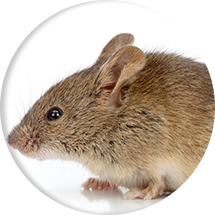
House Mouse Mus domesticus
Appearance:
- 7-10 cm in length, with equal tail and body length.
- 13-30g in weight.
- Small feet & head, large eyes and ears.
- Grey brown.
Life Cycle:
- 4-16 young per litter.
- 7-8 litters per year.
- Gestation period is 3 weeks.
- Sexual maturity is reached in 8-12 weeks.
Habits:
- Ground living but can climb.
- Mainly eats cereals.
- Eats up to 3g of food per day without additional water.
Control:
- Trapping – Proofing – Rodenticides – Tamper Proof Bait Stations.
Economic Damage of Rodents
Rodents account for huge economical losses by directly or indirectly damaging goods and contaminating foodstuffs leading to business shut downs. They directly damage the fabric of building structures by gnawing on electrical wires and can start fires. They eat through insulation, packaging and pipe structures causing untold damage in sewers and around building foundations. They spread diseases like leptospirosis and salmonellosis. The list goes on and on they must be stopped. So if you have a problem call Pest Patrol and we’ll stop them before they do damage to your property or health!
Flying Insects
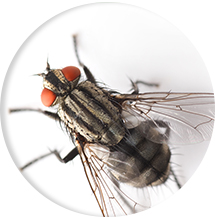
House Fly Musca Domestica Linnaeus
Appearance:
- Adult 5-8mm, thorax grey with narrow stripes.
- Larva 12mm long when mature, white tapered to a point at head end.
Life Cycle:
- Eggs are laid in 120-150 eggs per batch and hatch in 1/3 3 days.
- Larva will take 3-60 days to mature.
- Pupae 3-28days.
Habits:
- Found in all types of premises.
- Breeds in moist decaying vegetable matter.
Control:
- Baiting – Proofing – Flyscreens – Electronic Fly Killer Units – Insecticides – Fogging.
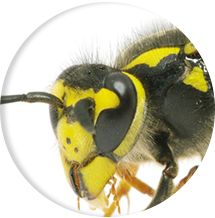
Social Wasps Vespidae
Appearance:
- Yellow and Black Abdomen.
Life Cycle:
- Young Queens overwinter and emerge in spring to start nest building and lay eggs.
- Workers emerge during early summer and take over nest building. The queen continues laying eggs.
- New Queens and males mate in early autumn.
- Only the Queens survive into next year.
Habits:
- Nests in Lofts, wall cavities, garden sheds, hollow trees and underground burrows.
- Colony size from 2000 – 25000.
- Food insects and sweet foods.
- Stings repeatedly.
Control:
- Proofing – Wasp Domes – Flyscreens – Electronic Fly Killers – Insecticides.
Crawling Insects
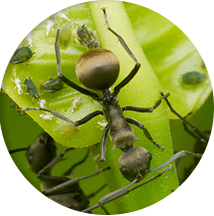
Ants Lasius niger
Appearance:
- Workers 4-5mm long.
- Queens 15mm long.
- Dark brown black in colour.
Life Cycle:
- Queens overwinter in soil eggs are laid in late spring Larvae hatch in 3-4 weeks.
- Workers emerge and continue with larval care, nest building and foraging for food.
- Fertile males and queens produced in mid to late summer (Alates and Swarmers).
Habits:
- Foraging workers follow well-defined trails to food sources.
- Nests found mainly outdoors in soil or below paving slabs on the sunny side of buildings.
Control:
- Proofing – Bait Stations – Insecticides – Fogging – Cleaning.
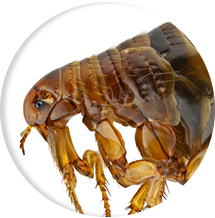
Fleas Various Species
Appearance:
- 2-3mm long.
- Very flattened from side to side and with well-developed spines and jumping legs.
- Mouthparts adapted to piercing and sucking.
- Red to brown in colour.
Life Cycle:
- Several hundred eggs laid in groups of 4 to 8.
Habits:
- Larva feed on organic matter and partially digested blood excreted by the adult.
- Adults feed on the blood of the species to which they are adapted. But cat, dog and bird fleas often bite humans.
- Adults can survive several weeks without a blood meal.
Control:
- Insecticides – Fogging – Veterinary Treatments for pets – Cleaning.
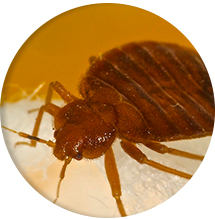
Bed Bugs Cimex lectularius
Appearance:
- 4-5mm long.
- Oval and flattened from back to underside, well-developed legs, but wings absent.
- Mouthparts adapted to piercing and sucking.
- Red to brown in colour.
Life Cycle:
- 200 500 eggs laid over a 2-month period in batches of 10 to 50.
Habits:
- Feed on human blood.
- Found in cracks and crevices, headboards, behind peeling wallpaper, broken plaster, light switches, under carpet and skirting boards etc.
- Bed bugs are nocturnal.
Control:
- Monitoring – Insecticides – Fogging – Cleaning – Heat Treatments.
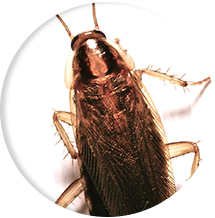
German Cockroaches Blatella germanica
Appearance:
- 12 – 15mm long.
- Brown with 2 dark stripes on the thorax.
- The wings are as long as the body or slightly overlapping in both sexes.
- Runs and climbs.
Life Cycle:
- Females carry 35-40 eggs in an ootheca (egg case) until they are ready to hatch.
- Hatch in 1 month.
- Nymphs take between 6 weeks to 6 months to develop into adults.
Habits:
- Heated Buildings, often kitchens and ships, prefers high temperatures & humidity.
- Nocturnal.
- Omnivorous.
Control:
- Monitoring – Baiting – Insecticides – Fogging – Cleaning – Heat Treatments.
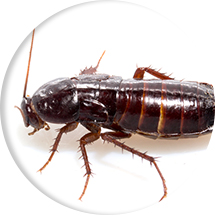
Oriental Cockroaches Blatta orientalis
Appearance:
- 25 – 30mm long.
- Dark brown to black in colour.
- The wings underdeveloped in the female and cover length of the abdomen in the male.
- Runs rather than flies.
Life Cycle:
- Females deposit 16 eggs in an ootheca (egg case).
- Hatch in 2 months.
- Nymphs take 5-9 months to develop into adults.
Habits:
- Buildings. Can tolerate lower temperatures than other cockroaches so can also be found outdoors on rubbish tips etc.
- Nocturnal.
- Omnivorous.
Control:
- Monitoring – Baiting – Insecticides – Fogging – Cleaning – Heat Treatments.
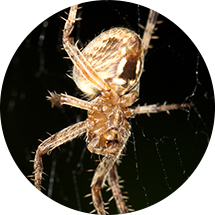
Spiders Arachnida
Appearance:
- Body soft and small, ~8mm long, but the 8 legs are long and may span up to 50 mm.
- Four pairs of legs.
- Generally greyish-brown in colour.
Life Cycle:
- Eggs are laid in large batches in small silk cocoons.
- The eggs hatch and the female feeds the young for the first few days.
- There are 4 molts, occurring at intervals of 1 to 4 weeks.
- Adults may live for 2 years.
Habits:
- Feed on Insects
- Objectionable only by their presence and their habit of spinning webs.
- Beneficial as predators all spiders are predatory, mainly preying on insects.
- Larger spiders may try to bite humans if alarmed, but are generally incapable of piercing human skin.
- Tropical spiders may be imported with goods some may be dangerous to humans, e.g. Black widow (Latrodectus mactans).
Control:
- Insecticides – Fogging – Cleaning.
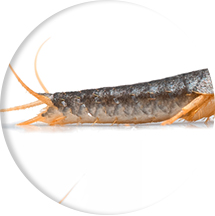
Silverfish Lepisma saccharina
Appearance:
- 12 mm long. Torpedo shaped with 3 long bristles at end of the abdomen.
- Wingless with long antennae.
- Silverfish are a silver grey colour.
Life Cycle:
- Eggs are laid in crevices.
- Adults live for 1-3 years.
Habits:
- Run quickly.
- Silverfish favour moist, warm conditions.
- Feed on food debris, starches and gums and are active at night.
- Minor pests of kitchens, libraries and commercial premises.
Control:
- Insecticides – Fogging – Cleaning.
OTHER NUISANCE PESTS
Common Clothes Moth Tineola bisselliella | Case-Bearing Clothes Moth Tinea pellionella | Woodlouse Isopoda | Stored Product Pests (Weevils, Confused Flour Beetles, Flour Mites) | Booklice (Liposcelis bostrychophila) | Lesser House Flies Fannia canicularis | Bluebottle (Blowfly) Calliphora vomitoria | Cluster Flies Pollenia rudis | Pharoh Ants Monomorium pharaonis | Bird Mites Dermanyssus gallinae
Birds
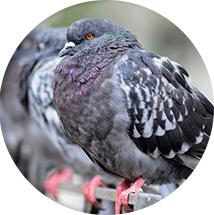
Feral Pigeon Columba livia
Appearance:
- 32 cm long.
- Blue grey in colour.
Life Cycle:
- 2-3 broods per year, with 2 eggs in each clutch.
- 17-19 day incubation period.
- Young birds spend 35-37 days in the nest.
Habits:
- Feeds on seeds, green feed, domestic scraps in and around cities, near roosting sites.
- Nests on ledges and in the roof spaces of old buildings.
Control:
- Structural Proofing – Netting – Spike Systems – Culling.
OTHER PROBLEM BIRDS
Gulls Laridae | Crows Corvidae
OTHER NUISANCE PESTS
OTHER NUISANCE PESTS:
- Common Clothes Moth Tineola bisselliella
- Case-Bearing Clothes Moth Tinea pellionella
- Woodlouse Isopoda
- Stored Product Pests (Weevils, Confused Flour Beetles, Flour Mites)
- Booklice (Liposcelis bostrychophila)
- Lesser House Flies Fannia canicularis
- Bluebottle (Blowfly) Calliphora vomitoria
- Cluster Flies Pollenia rudis
- Pharoh Ants Monomorium pharaonis
- Bird Mites Dermanyssus gallinae

